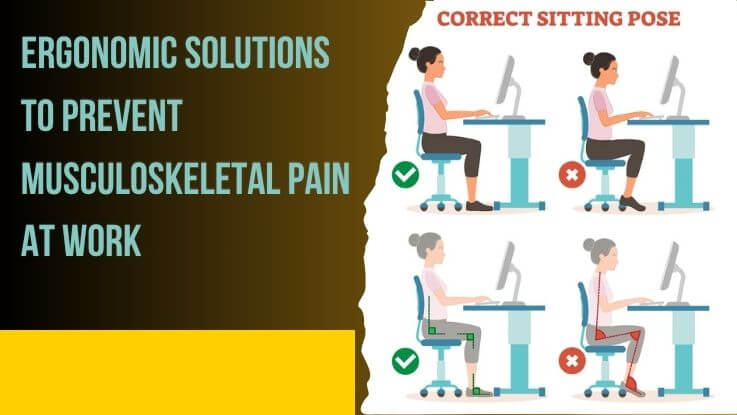Musculoskeletal pain is a common issue for many professionals, especially those who spend long hours at desks or performing repetitive tasks. Poor workplace ergonomics can lead to discomfort, reduced productivity, and even chronic conditions. By implementing ergonomic tips, you can create a healthier work environment, reduce strain, and prevent musculoskeletal pain.
What Is Musculoskeletal Pain?
Musculoskeletal pain refers to discomfort or pain in the muscles, bones, joints, tendons, ligaments, or nerves. It often results from repetitive movements, poor posture, prolonged sitting, or improper workstation setups. Common areas affected include the neck, shoulders, back, wrists, and knees. Symptoms may range from mild aches to severe, debilitating pain, impacting daily activities and work performance. Workplace-related musculoskeletal disorders (MSDs) are a leading cause of absenteeism, with the U.S. Bureau of Labor Statistics reporting over 272,000 cases of work-related MSDs in 2020.
What Are Ergonomic Tips?
Ergonomic tips are practical strategies and adjustments designed to optimize your workspace and work habits to reduce physical strain. Ergonomics focuses on aligning the workplace with the body’s natural movements and capabilities, promoting comfort and efficiency. These tips include adjusting chair height, using supportive equipment, maintaining proper posture, and incorporating movement into your routine. Proper ergonomics can prevent musculoskeletal pain, improve productivity, and enhance overall well-being.
Key Ergonomic Tips to Prevent Musculoskeletal Pain
1. Optimize Your Workstation Setup
- Adjust Your Chair: Ensure your chair supports your lower back with adjustable lumbar support. Your feet should rest flat on the floor, and your knees should be at a 90-degree angle.
- Monitor Height: Position your computer monitor at eye level, about 20–30 inches from your face, to avoid neck strain.
- Keyboard and Mouse Placement: Keep your keyboard and mouse close to your body, with your elbows at a 90-degree angle to reduce shoulder and wrist strain.
2. Maintain Proper Posture
- Sit with your back straight, shoulders relaxed, and head aligned with your spine. Avoid slouching or leaning forward, which can strain your neck and back.
- Use a chair with adjustable armrests to support your arms without elevating your shoulders.
3. Take Regular Breaks
- Follow the 20-20-20 rule: Every 20 minutes, look at something 20 feet away for 20 seconds to reduce eye and neck strain.
- Stand, stretch, or walk for 1–2 minutes every hour to improve circulation and reduce muscle stiffness.
4. Use Ergonomic Equipment
- Invest in an ergonomic chair with adjustable features to support your spine’s natural curve.
- Consider a standing desk or a desk converter to alternate between sitting and standing.
- Use an ergonomic keyboard and mouse to minimize wrist strain, especially for repetitive tasks.
5. Incorporate Movement and Stretching
- Perform simple stretches, such as neck rolls, shoulder shrugs, and wrist flexes, to relieve tension.
- Engage in light physical activity, like walking during lunch breaks, to counteract prolonged sitting.
6. Organize Your Workspace
- Keep frequently used items within arm’s reach to avoid excessive stretching or twisting.
- Ensure proper lighting to reduce eye strain and prevent leaning forward to see your screen.
Medical Treatments for Musculoskeletal Pain
If musculoskeletal pain persists despite ergonomic adjustments, medical intervention may be necessary. Here are common treatment options:
- Physical Therapy: A physical therapist can design a personalized exercise program to strengthen muscles, improve flexibility, and reduce pain. Techniques like manual therapy or ultrasound may also be used.
- Medications: Over-the-counter pain relievers like ibuprofen or acetaminophen can reduce inflammation and pain. Prescription medications, tablets ( aspadol, tapentadol) such as muscle relaxants, may be recommended for severe cases.
- Injections: Corticosteroid injections can provide temporary relief for inflamed joints or tissues. Trigger point injections may help with muscle knots.
- Chiropractic Care: Spinal adjustments and manipulations can alleviate pain caused by misaligned joints or poor posture.
- Surgery: In rare cases, surgery may be required for conditions like herniated discs or severe carpal tunnel syndrome. This is typically a last resort after non-invasive treatments fail.
- Alternative Therapies: Acupuncture, massage therapy, or dry needling may help reduce pain and improve mobility for some individuals.
Always consult a healthcare professional for a proper diagnosis and treatment plan tailored to your condition.
Additional Tips for Long-Term Prevention
- Strengthen Core Muscles: A strong core supports your spine and reduces the risk of back pain. Incorporate exercises like planks or yoga into your routine.
- Stay Hydrated: Proper hydration supports muscle function and reduces the risk of cramps or stiffness.
- Manage Stress: Chronic stress can lead to muscle tension. Practice relaxation techniques like deep breathing or meditation to stay relaxed.
- Use a Standing Desk: Alternating between sitting and standing reduces static strain on muscles and joints.
- Wear Supportive Footwear: If your job involves standing for long periods, wear shoes with proper arch support to prevent leg and back pain.
FAQs
1. What are the most common causes of musculoskeletal pain at work?
Repetitive motions, poor posture, prolonged sitting or standing, and improper workstation setups are the primary causes. Heavy lifting, awkward positions, and lack of movement also contribute.
2. How can I tell if my musculoskeletal pain is serious?
If pain persists for more than a few weeks, worsens over time, or is accompanied by numbness, tingling, or weakness, consult a doctor. These could indicate conditions like nerve compression or a herniated disc.
3. How often should I take breaks to prevent musculoskeletal pain?
Take a 1–2 minute break every hour to stretch or move. Follow the 20-20-20 rule for eye and neck relief, especially if working at a computer.
4. Are ergonomic chairs worth the investment?
Yes, ergonomic chairs with adjustable lumbar support, seat height, and armrests can significantly reduce strain and prevent pain, especially for those sitting for long hours.
5. Can stress worsen musculoskeletal pain?
Yes, stress can cause muscle tension, particularly in the neck and shoulders, exacerbating pain. Relaxation techniques and ergonomic adjustments can help mitigate this.
